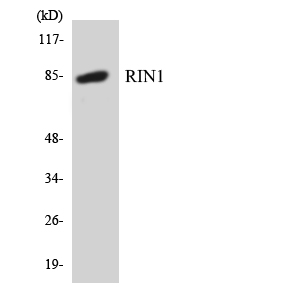产品名称
RIN1 Rabbit Polyclonal Antibody
别名
RIN1; Ras and Rab interactor 1; Ras inhibitor JC99; Ras interaction/interference protein 1
蛋白名称
Ras and Rab interactor 1
存储缓冲液
Liquid in PBS containing 50% glycerol, 0.5% BSA and 0.02% New type preservative N.
Human Gene Link
http://www.ncbi.nlm.nih.gov/sites/entrez?db=gene&term=9610
Human Swissprot No.
Q13671
Human Swissprot Link
http://www.uniprot.org/uniprotkb/Q13671/entry
Mouse Gene Link
http://www.ncbi.nlm.nih.gov/sites/entrez?db=gene&term=225870
Mouse Swissprot No.
Q921Q7
Mouse Swissprot Link
http://www.uniprot.org/uniprot/Q921Q7
Rat Gene Link
http://www.ncbi.nlm.nih.gov/sites/entrez?db=gene&term=207119
Rat Swissprot Link
http://www.uniprot.org/uniprot/P97680
免疫原
The antiserum was produced against synthesized peptide derived from human RIN1. AA range:655-704
特异性
RIN1 Polyclonal Antibody detects endogenous levels of RIN1 protein.
稀释度
WB 1:500-2000;IHC-p 1:50-300; ELISA 2000-20000
宿主
Polyclonal, Rabbit,IgG
背景介绍
function:Ras effector protein, which may serve as an inhibitory modulator of neuronal plasticity in aversive memory formation. Can affect Ras signaling at different levels. First, by competing with RAF1 protein for binding to activated Ras. Second, by enhancing signaling from ABL1 and ABL2, which regulate cytoskeletal remodeling. Third, by activating RAB5A, possibly by functioning as a guanine nucleotide exchange factor (GEF) for RAB5A, by exchanging bound GDP for free GTP, and facilitating Ras-activated receptor endocytosis.,PTM:Phosphorylated on tyrosine residues by ABL1 and ABL2. Phosphorylated on Ser-351 by PKD.,similarity:Belongs to the RIN (Ras interaction/interference) family.,similarity:Contains 1 Ras-associating domain.,similarity:Contains 1 SH2 domain.,similarity:Contains 1 VPS9 domain.,subcellular location:Some amount is membrane-associated.,subunit:Interacts with the GTP-bound form of Ras proteins (NRAS, HRAS and KRAS). This interaction prevents the association between RAF1 and Ras. Interacts with 14-3-3 proteins YWHAB, YWHAE and YWHAZ when phosphorylated on Ser-351. Interacts with the SH3 domain of ABL1 and ABL2. Interacts with RAB5A. The interaction with Ras is probably regulated and antagonized by the interaction with 14-3-3 proteins. The interaction with 14-3-3 proteins is regulated by phosphorylation on Ser-351.,tissue specificity:Expressed in all tissues examined with high levels in brain, placenta and pancreas.,
组织表达
Expressed in all tissues examined with high levels in brain, placenta and pancreas.
细胞定位
Cytoplasm . Membrane . Cytoplasm, cytoskeleton . Some amount is membrane-associated.
功能
function:Ras effector protein, which may serve as an inhibitory modulator of neuronal plasticity in aversive memory formation. Can affect Ras signaling at different levels. First, by competing with RAF1 protein for binding to activated Ras. Second, by enhancing signaling from ABL1 and ABL2, which regulate cytoskeletal remodeling. Third, by activating RAB5A, possibly by functioning as a guanine nucleotide exchange factor (GEF) for RAB5A, by exchanging bound GDP for free GTP, and facilitating Ras-activated receptor endocytosis.,PTM:Phosphorylated on tyrosine residues by ABL1 and ABL2. Phosphorylated on Ser-351 by PKD.,similarity:Belongs to the RIN (Ras interaction/interference) family.,similarity:Contains 1 Ras-associating domain.,similarity:Contains 1 SH2 domain.,similarity:Contains 1 VPS9 domain.,subcellular location:Some amount is membrane-associated.,subunit:Interacts with the GTP-bound form of Ras proteins (NRAS, HRAS and KRAS). This interaction prevents the association between RAF1 and Ras. Interacts with 14-3-3 proteins YWHAB, YWHAE and YWHAZ when phosphorylated on Ser-351. Interacts with the SH3 domain of ABL1 and ABL2. Interacts with RAB5A. The interaction with Ras is probably regulated and antagonized by the interaction with 14-3-3 proteins. The interaction with 14-3-3 proteins is regulated by phosphorylation on Ser-351.,tissue specificity:Expressed in all tissues examined with high levels in brain, placenta and pancreas.,
纯化
The antibody was affinity-purified from rabbit antiserum by affinity-chromatography using epitope-specific immunogen.


